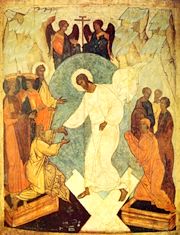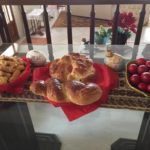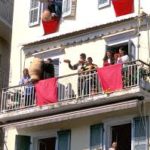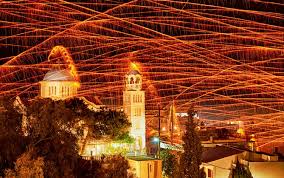 Easter (Greek: Πάσχα) is the celebration of the resurrection of Jesus Christ from the dead. The Greek Orthodox Church and all the Christian Churches around the world celebrate the resurrection of Jesus described as having occurred on the third day after his burial when he was crucified by the Romans at Calvary around 30 A.D. As Easter is in the spring, it not only symbolizes the rebirth of life, but also of nature after a long hard winter just as in the ancient Greek myth of Persephone, who had to live in the Underworld for six months of the year and returned to earth in the spring. It is the time of rebirth, fulfillment and joy.
Easter (Greek: Πάσχα) is the celebration of the resurrection of Jesus Christ from the dead. The Greek Orthodox Church and all the Christian Churches around the world celebrate the resurrection of Jesus described as having occurred on the third day after his burial when he was crucified by the Romans at Calvary around 30 A.D. As Easter is in the spring, it not only symbolizes the rebirth of life, but also of nature after a long hard winter just as in the ancient Greek myth of Persephone, who had to live in the Underworld for six months of the year and returned to earth in the spring. It is the time of rebirth, fulfillment and joy.
The period after Clean Monday or Ash Monday is the 40 days of Lent leading up to the Easter celebrations, which begin on Palm Sunday (Greek: Κυριακή των Βαϊων). This is the day when Jesus entered Jerusalem on a donkey and the people threw down palm leaves to welcome him. During this last week of Jesus’ life on earth, also referred to as Holy Week (Greek: Μεγάλη Εβδομάδα), each day is symbolic and various traditions are carried out throughout Greece. People fast and go to evening services. On Holy Thursday (Greek: Μεγάλη Πέμπτη), the Last Supper that Jesus had with the twelve Apostles is celebrated. The Twelve Gospels that are heard during the church service describe Jesus’ arrest in the Grove of Olives or Gethsemane (Greek: Γεσθημανή) due to His betrayal by Judas, His trial and torture and finally His crucifixion on Golgotha or Calvary (Greek: Γολγοθά). The site was identified by Helena of Constantinople, the mother of Emperor Constantine I in 325 A.D. It is the site where Jesus Christ was  crucified and the tomb where He was buried and resurrected. The Church of the Holy Sepulchre (Greek: Ναός της Αναστάσεως) has been built here and is under the jurisdiction of the Greek Orthodox Church. Only a Greek Orthodox priest is able to enter the tomb and bring out the Holy Light, which is then given to the congregation waiting to receive it. The phrases: Christos Anesti (Greek: Χρηστός Ανέστη – Christ has risen) and Alithos Anesti (Greek: Αληθώς Ανέστη – Truly, Christ has risen) are heard as each person lights the candle from the person next to him.
crucified and the tomb where He was buried and resurrected. The Church of the Holy Sepulchre (Greek: Ναός της Αναστάσεως) has been built here and is under the jurisdiction of the Greek Orthodox Church. Only a Greek Orthodox priest is able to enter the tomb and bring out the Holy Light, which is then given to the congregation waiting to receive it. The phrases: Christos Anesti (Greek: Χρηστός Ανέστη – Christ has risen) and Alithos Anesti (Greek: Αληθώς Ανέστη – Truly, Christ has risen) are heard as each person lights the candle from the person next to him.
Holy Thursday is the day on which the eggs are dyed red and the Easter biscuits (Gree k: κουλούρια) and tsourekia or sweet Easter bread (Greek: τσουρέκια) are made. The red eggs symbolise the blood of Jesus Christ as well as the tomb in which Jesus was buried.
k: κουλούρια) and tsourekia or sweet Easter bread (Greek: τσουρέκια) are made. The red eggs symbolise the blood of Jesus Christ as well as the tomb in which Jesus was buried.
Holy Friday is a day of mourning and fasting. The church bells ring the death knell and the shops are closed until midday. Girls decorate the Epitaphio (Greek: Επιτάφιος) which will bear the richly embroidered cloth of the dead body of Jesus Christ. After the evening service, the Epitaphio is taken through the streets followed by the people holding dark-coloured candles that symbolise mourning and chanting the eulogies of the Epitaphio.
 On Holy Saturday, after the resurrection of Christ, the congregation will light white candles from the Holy Light that is brought out from the Tomb of Jesus Christ within the Church of the Holy Sepulchre in Jerusalem. It is brought to Greece on a special flight. The people will take the lit candle home and make a cross on the doorway of their house for good luck before entering it. A midnight meal of mageiritsa (a type of soup made of lamb ofal) is eaten and the red eggs are cracked. This symbolise the opening of the tomb. The person whose egg is not cracked is considered the winner. Holy Sunday is a day of celebration where lambs are put on the spit or roasted in the oven, along with drinking, music and dancing followed by the cracking of eggs and the eating of koulouria and tsoureki and other traditional sweets depending on the area.
On Holy Saturday, after the resurrection of Christ, the congregation will light white candles from the Holy Light that is brought out from the Tomb of Jesus Christ within the Church of the Holy Sepulchre in Jerusalem. It is brought to Greece on a special flight. The people will take the lit candle home and make a cross on the doorway of their house for good luck before entering it. A midnight meal of mageiritsa (a type of soup made of lamb ofal) is eaten and the red eggs are cracked. This symbolise the opening of the tomb. The person whose egg is not cracked is considered the winner. Holy Sunday is a day of celebration where lambs are put on the spit or roasted in the oven, along with drinking, music and dancing followed by the cracking of eggs and the eating of koulouria and tsoureki and other traditional sweets depending on the area.
Many traditions take place in various parts of Greece. The better known ones are on the islands of Patmos, Corfu and Chios. Patmos is the island where the Book of Apocalypse or Book of Revelation (Greek: Αποκάλυψη του Ιωάννη) was written by John the Apostle. During Holy Week the Christian rituals such as the Washing of the Disciple’s feet and the Deposition of Christ’s body from the Cross can be observed.
traditions take place in various parts of Greece. The better known ones are on the islands of Patmos, Corfu and Chios. Patmos is the island where the Book of Apocalypse or Book of Revelation (Greek: Αποκάλυψη του Ιωάννη) was written by John the Apostle. During Holy Week the Christian rituals such as the Washing of the Disciple’s feet and the Deposition of Christ’s body from the Cross can be observed.

On the island of Corfu, on the morning of Holy Saturday, the first resurrection service (Greek: Μικρί Ανάσταση) is celebrated. The bells ring happily and the bands parade through the streets. It is customary for the locals to drop pots painted red from their windows or balconies onto the square below. Over the years, it has become a tourist attraction with many people visiting Corfu to see this tradition.
 On the island of Chios, on Holy Saturday night when the bells ring happily to celebrate the resurrection of Christ and the people light their candles from the Holy Light, two groups of locals in the village of Vrontados are ready to let off thousands of rockets which pass over the houses and the tops of the churches. This tradition attracts many visitors to the island every Easter.
On the island of Chios, on Holy Saturday night when the bells ring happily to celebrate the resurrection of Christ and the people light their candles from the Holy Light, two groups of locals in the village of Vrontados are ready to let off thousands of rockets which pass over the houses and the tops of the churches. This tradition attracts many visitors to the island every Easter.
Besides the traditions connected with the religious side of Easter, there are traditions connected with the duty that a godfather or godmother has to his/her godson/daughter. In the past, it was customary for them to buy an Easter candle and a pair of shoes for their godson/goddaughter. But today, clothes and toys are also bought. This tradition is connected with the fact that in the past money was difficult to come by and therefore a pair of shoes was seen as something special. This tradition also makes reference to the new season of spring as the old winter clothes will be put away and the new shoes and clothes will be worn on Holy Saturday when the body of Christ is resurrected and the Easter candle is lit. It is a custom that all children look forward to as there is now a large variety of candles, clothes and toys to cater for all tastes.